Must have been a terrifying funeral…
June 24, 2013 by TimHughes · Leave a Comment
The “Richmond Enquirer” newspaper from Virginia, issue of December 8, 1821, included this very interesting article titled: “Resurrection From The Grave”. While the inking makes it a bit difficult to read, please… enjoy?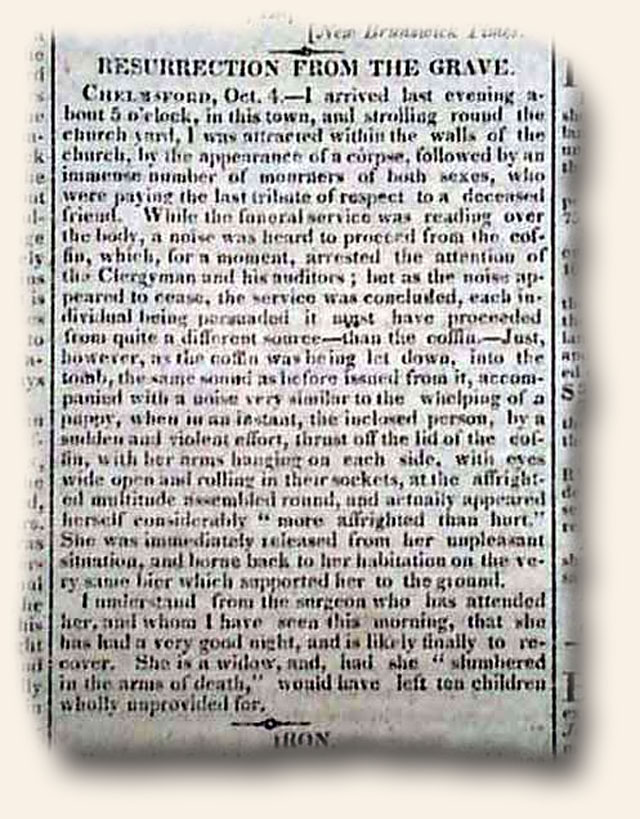
The post-Civil War: an era rich in history…
May 27, 2013 by TimHughes · Leave a Comment
 Few eras of American history have been romanticized as the Post-Civil War 19th Century. For those who grew up in the 1950’s & 1960’s, television had more than its fair share of Western-themed shows. And the “Wild West” was a common feature on the silver screen as well.
Few eras of American history have been romanticized as the Post-Civil War 19th Century. For those who grew up in the 1950’s & 1960’s, television had more than its fair share of Western-themed shows. And the “Wild West” was a common feature on the silver screen as well.
Not only can one capture a flavor of that time when the American frontier was pushing further West, but actual historical events can be read as captured in newspapers of the day, when the events happened. This is the intrigue of collecting rare and historic newspapers.
From the moment the Civil War ended, the national focus was on the lands west of the Mississippi. It was common to find reports, even in newspapers from the big cities of the East, of skirmishes with Indians on the Great Plains and elsewhere. The Custer Massacre perhaps ranking as the most notable, but reports can be found on the Battle of Wounded Knee, Captain Jack and the Modoc Indian War, reports of Geronimo, Sitting Bull, the Apaches and others. Newspapers are a great resource for those wishing to explore/collect Native American history.
And what about Outlaws & Gunfights? Stage coach robbery reports are not an uncommonly found in newspapers from the 1870’s and 1880’s, and train robberies and bank robberies could be found scattered throughout newspapers of this period as well. It was a time when some of the more famous—and infamous–names of American history could be found in newspapers, including Jesse James and his gang, Billy the Kid, Wyatt Earp (yes, there are newspaper reports of the Gunfight at the O.K. Corral), the Dalton Gang, Younger brothers, Robert Ford, Buffalo Bill, Jim Bridger, Vasquez, Doc Holliday, Kit Carson, Lizzie Borden, and on and on. Although “Jack the Ripper” was a name from London crime history his deeds made headlines on this side of the Atlantic as well. Reports of their deeds are not fictionalized; they are the events as reported in newspaper accounts of the day.
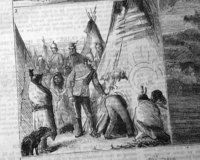 Some the famous towns of the Old West had their own newspapers and can be purchased for anyone’s collection, including titles from Tombstone, Leavenworth, Deadwood, Tucson, Reno, San Francisco, Leadville, Carson City, Denver, Salt Lake City, and many more.
Some the famous towns of the Old West had their own newspapers and can be purchased for anyone’s collection, including titles from Tombstone, Leavenworth, Deadwood, Tucson, Reno, San Francisco, Leadville, Carson City, Denver, Salt Lake City, and many more.
Although crime reports were common, there is so much more in newspapers from this era. Politics certainly found their way into newspapers on a daily basis. Ulysses S. Grant and James Garfield were perhaps the most notable Presidents of the era, and reports on the latter’s assassination are commonly found. Science and innovation were the focus of the famous title “Scientific American” which began in 1845 and still publishes today. Within its pages were many reports on Thomas Edison, Alexander Graham Bell and their inventive work, plus illustrations of the creations of many of the devices and improvements we still enjoy today. Many were first unveiled in Philadelphia’s Centennial Exposition of 1876 and the Columbian Exposition at Chicago in 1893.
It was a time when Brigham Young and the Mormons were venturing west, ultimately to settle in the Salt Lake City Valley. P.T. Barnum was making news with his circus, and Frederick Douglass & Booker T. Washington were coming to national prominence as spokesmen for the newly emancipated slaves. The Chicago Fire & the Johnstown Flood were but two disasters which changed the American landscape and graphic accounts were more brutal in the 19th century then they are today. 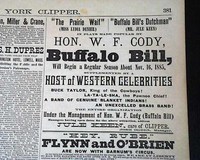 As is the case with present-day newspapers, sporting reports were typically found, with baseball, football, tennis and golf gaining widespread popularity as diversions for not just the wealthy but for everyone.
As is the case with present-day newspapers, sporting reports were typically found, with baseball, football, tennis and golf gaining widespread popularity as diversions for not just the wealthy but for everyone.
As you see the post-Civil War era was very rich in history. And I only touched on a few of the highlights. Newspapers of the era reported not just the events & names we know of through history books, but captured the mundane events of daily existence which provide a fascinating flavor of life in America when the wealth & prestige of the United States was emerging upon the world landscape. A world awaits the collector who delves into this fascinating era of American history.
Still a few more fools around…
March 22, 2013 by TimHughes · Leave a Comment
The headline (see below) pretty much says it all in this October 2, 1890 report in the “Allegany County Reporter“ of Wellsville, New York…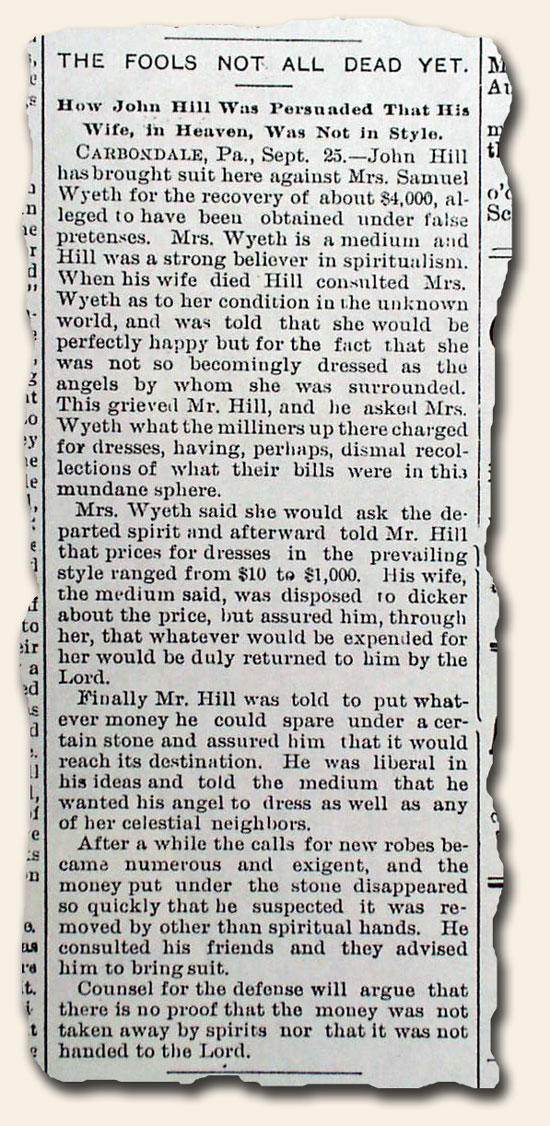
The Traveler… Conferedate president issues a proclamation… new establishments……
March 4, 2013 by The Traveler · Leave a Comment
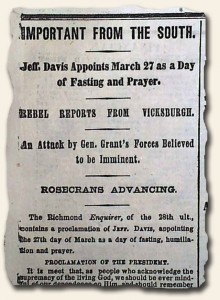 Today I decided to travel back to the era of the Civil War through The New York Times of March 4, 1863. In this issue I found the Southern President Jeff Davis had appointed March 27th to be a Day of Fasting and Prayer. “…Under these circumstances it is my privilege to invite you once more to meet together and prostrate yourselves in humble supplication to Him who has been our constant and never-failing support in the past, and to whose protection and guidance we trust for the future. To this end I, Jefferson Davis, President of the Confederate States of America, do issue this, my proclamation, setting apart Friday, the 27th day of March, as a day of fasting, humiliation and prayer…” This is also signed in type: JEFFERSON DAVIS.
Today I decided to travel back to the era of the Civil War through The New York Times of March 4, 1863. In this issue I found the Southern President Jeff Davis had appointed March 27th to be a Day of Fasting and Prayer. “…Under these circumstances it is my privilege to invite you once more to meet together and prostrate yourselves in humble supplication to Him who has been our constant and never-failing support in the past, and to whose protection and guidance we trust for the future. To this end I, Jefferson Davis, President of the Confederate States of America, do issue this, my proclamation, setting apart Friday, the 27th day of March, as a day of fasting, humiliation and prayer…” This is also signed in type: JEFFERSON DAVIS.
Also under the “Important from Washington” are the new establishments of “The New Banking Law”; “Designs for Currency Notes” due to the recent passing of the National Currency Act; “A Branch Mint in Nevada”; as well as the establishing of “The Territory of Idahoe (Idaho)” from within the territory of Montano (Montana). “Slavery is forever prohibited within the limits of the new Territory”.
What an incredible time in history!
~The Traveler
The Traveler… USS Constitution defeats HMS Java… River Raisin…
February 18, 2013 by The Traveler · Leave a Comment
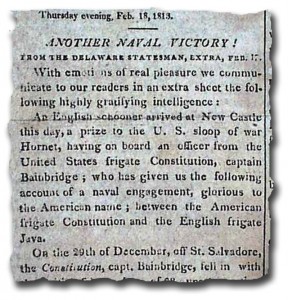 This week I traveled to Philadelphia, Pennsylvania, by way of the Aurora dated February 19, 1813. Here I found the report of “Another Naval Victory!” being reported “… On the 29th of December, off St. Salvadore, the Constitution, capt. Bainbridge, fell in with the British frigate Java, of 38 guns (mounting 49) and 400 men. After an action of one hour and forty-five minutes, the Java struck, with the loss of 60 killed and 170 wounded. The Constitution had 9 killed and 25 wounded… The Java was so much damaged in action, that it was deemed impossible to fetch her in, and by order of captain Bainbridge she was burnt…”.
This week I traveled to Philadelphia, Pennsylvania, by way of the Aurora dated February 19, 1813. Here I found the report of “Another Naval Victory!” being reported “… On the 29th of December, off St. Salvadore, the Constitution, capt. Bainbridge, fell in with the British frigate Java, of 38 guns (mounting 49) and 400 men. After an action of one hour and forty-five minutes, the Java struck, with the loss of 60 killed and 170 wounded. The Constitution had 9 killed and 25 wounded… The Java was so much damaged in action, that it was deemed impossible to fetch her in, and by order of captain Bainbridge she was burnt…”.
Also in this issue was the report of the battle at river Raisin, including the killing (scalping) of General Winchester and the further mutilation of his body. It is so hard to imagine what they went through in those battles. So much for nostalgia.
~The Traveler
The Traveler… the battle of Queenston…
October 22, 2012 by The Traveler · Leave a Comment
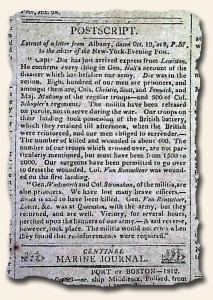 Today I journeyed to Boston, Massachusetts by way of the Columbian Centinel dated October 24, 1812. I found several reports in regards to the battle of Queenston, Canada. The reporting begins with Col. Van Rensselaer’s troops having crossed the Niagara River into Upper-Canada and that the batteries in Queenston were attacked . It is stated that Fort George was to have been immediately attacked with troops in Buffalo joining them. Further reports continue with actual loss of the battle and the Col. Van Rensselaer being shot and Gen. Wadsworth being missing, assumed dead. It is interesting to read the different accounts within one issue.
Today I journeyed to Boston, Massachusetts by way of the Columbian Centinel dated October 24, 1812. I found several reports in regards to the battle of Queenston, Canada. The reporting begins with Col. Van Rensselaer’s troops having crossed the Niagara River into Upper-Canada and that the batteries in Queenston were attacked . It is stated that Fort George was to have been immediately attacked with troops in Buffalo joining them. Further reports continue with actual loss of the battle and the Col. Van Rensselaer being shot and Gen. Wadsworth being missing, assumed dead. It is interesting to read the different accounts within one issue.
~The Traveler
Wyoming’s first newspapers…
July 9, 2012 by TimHughes · 1 Comment
Wyoming has the interesting distinction of having once been part of four principal annexations: the Louisiana Purchase, the Oregon Territory, the Mexican Cession and Texas Annexation. It became a territory in July, 1868 and gained statehood on July 10, 1890.
The “Leader” was the first newspaper in Wyoming, begun on September 19, 1867, the same year that the first settlement had been created at Cheyenne. The newspaper was begun by Nathan Baker and J.E. Gates. Baker gained his printing experience in Colorado, working at the “Rocky Mountain Herald” and the the “Rocky Mountain News”. He went one to establish two other newspapers in Wyoming, the Laramie “Sentinel” on May 1, 1869, and the South Pass “News“. See the hyperlink for the interesting history of this town.
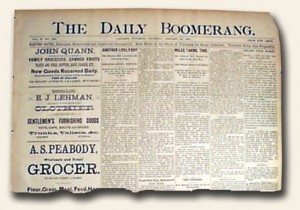 Also begun in Cheyenne in 1867 were the “Daily Argus” in October, and the “Star” in December, but neither one lasted beyond two years. Other early newspapers in Wyoming were the “Sweetwater Miner” at Fort Bridge in February, 1868, a vehicle to promote immigration, and a few months later the “News” at South Pass, noted above.
Also begun in Cheyenne in 1867 were the “Daily Argus” in October, and the “Star” in December, but neither one lasted beyond two years. Other early newspapers in Wyoming were the “Sweetwater Miner” at Fort Bridge in February, 1868, a vehicle to promote immigration, and a few months later the “News” at South Pass, noted above.
One of the more interesting newspapers from the West was the “Frontier Index” which began at Fort Sanders and moved along with the Union Pacific railroad going to Benton then to Bryan and then to Bear River City where it was completely destroyed by a mob. And no mention of Wyoming’s newspaper history should fail to mention the “Boomerang” (named for the editor’s mule), founded at Laramie on March 11, 1881 by Bill Nye. Subscribers were found in every state and some foreign countries. When Nye retired from the paper he became one of America’s best known humorists.
The Traveler… war declared…
June 18, 2012 by The Traveler · Leave a Comment
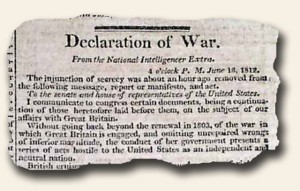 Today I journeyed to Baltimore, Maryland, through The Weekly Register dated June 20, 1812. Within this issue is the announcement of the Declaration of War “between the United Kingdom of Great Britain and Ireland… and the United States of America and their territories”, signed by JAMES MADISON, June 18, 1812. The final passage vote of the act in the Senate was 19 to 13 and in the House was 79 to 49. This article entitled “Declaration of War” is approximately 5 1/2 pages in length.
Today I journeyed to Baltimore, Maryland, through The Weekly Register dated June 20, 1812. Within this issue is the announcement of the Declaration of War “between the United Kingdom of Great Britain and Ireland… and the United States of America and their territories”, signed by JAMES MADISON, June 18, 1812. The final passage vote of the act in the Senate was 19 to 13 and in the House was 79 to 49. This article entitled “Declaration of War” is approximately 5 1/2 pages in length.
With news like this being reported, nothing more needs to be said… and likely little else was read… as life was about to drastically change.
~The Traveler
Marriage ceremony etiquette infraction?
March 31, 2012 by GuyHeilenman · Leave a Comment
I thought the groom was not supposed to “see” the bride on her wedding day until she walked down the isle? The groom apparently had other pressing concerns he felt trumped proper wedding etiquette. His behavior is quite revealing as to his true intentions (New York American, December 18, 1827):
The first newspaper in Utah…
March 26, 2012 by TimHughes · Leave a Comment
The Mormons created a great migration to the West in 1847 as 2000 Mormons crossed the western plains seeking a location in which they could follow undisturbed the precepts of their religion. The first party reached the Salt Lake valley on July 24, 1847, and among the items they brought were implements, seeds, cattle, sheep, hogs, chickens, and a printing outfit purchased in Philadelphia.
At the time the area was owned by Mexico, but with the treaty of 1848 ending the Mexican ar ownership passed to the United States. With no steps taken by federal authorities to establish a system of government for it, the Mormons took matters into their own hands and in 1849 organized the “State of Deseret” (land of the honey bee) with Brigham Young as governor.
The very first issue of the “Deseret News” was printed on June 15, 1850 with Brigham Young noted as the publisher and Horace Whitney, who had printing experience at the Mormon town of Nauvoo, Illinois, listed as the printer. This newspaper continued for just over a year when it was suspended for 3 months due to lack of paper. It began as a weekly but four months later became a semi-monthly until 1854 when it again became a weekly. It eventually became a daily on Nov. 21, 1867. A sample of a volume 1 issues may be found at: Deseret News, August 17, 1850
It was in late 1858 when Kirk Anderson started the “Valley Tan” in Salt Lake City, lasting for just over a year. The “Mountaineer” was started on Aug. 27, 1859 and “Farmer’s Oracle” was a semi-monthly which began on May 22, 1863, both of which lasted for less than two years. A military newspaper titled the “Union Vidette” began on Nov. 20, 1863, done by soldiers stationed at Camp Douglass, a military post near Salt Lake City.


